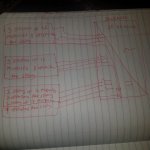hhsting
Senior Member
- Location
- Glen bunie, md, us
- Occupation
- Junior plan reviewer
Attached sketch shows following going into SE 43.21KUS:
1. 3 strings of 16 modules 8 optimizer per string
2. 3 strings of 16 modules 8 optimizers per string
3. 1 string of 16 modules 8 optimizers per string
1 string of 18 modules 9 optimizers per string
Total of 8 strings go to inverter but separated into less than or equal to 3 strings. Not sure if grouping like as shown total of 3 groups makes difference if each group is isolated from each other or not. The question is designer is not showing any combiner boxes. Do they need combiner boxes? If no why not and if yes then why.
1. 3 strings of 16 modules 8 optimizer per string
2. 3 strings of 16 modules 8 optimizers per string
3. 1 string of 16 modules 8 optimizers per string
1 string of 18 modules 9 optimizers per string
Total of 8 strings go to inverter but separated into less than or equal to 3 strings. Not sure if grouping like as shown total of 3 groups makes difference if each group is isolated from each other or not. The question is designer is not showing any combiner boxes. Do they need combiner boxes? If no why not and if yes then why.


